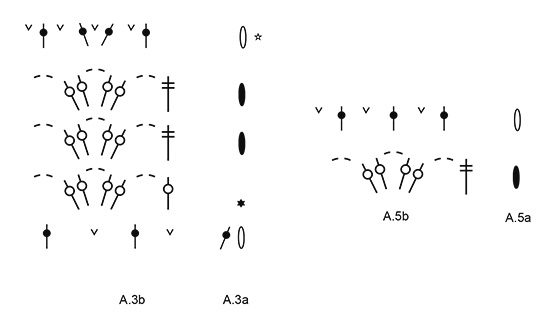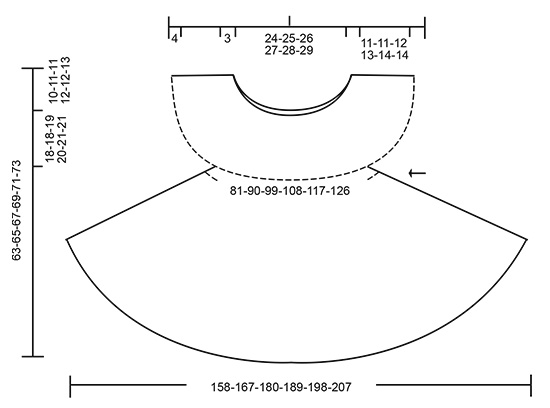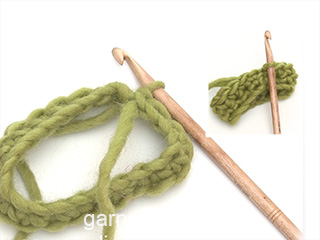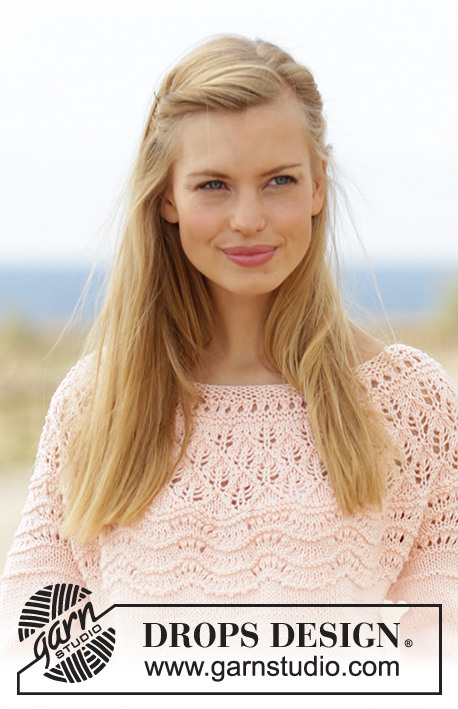Lizzy |
||||||||||||||||||||||||||||||||||||||||
 |
 |
|||||||||||||||||||||||||||||||||||||||
Tunic with fan pattern, flounce and A-shape, crochet top down in DROPS Safran. Size S-XXXL.
DROPS 176-2 |
||||||||||||||||||||||||||||||||||||||||
|
CROCHET INFO: At beginning of every round with double crochet replace first double crochet with 3 chain stitches. Finish round with 1 slip stitch in 3rd chain stitch at beginning of round. PATTERN: See diagrams A.1 to A.5. (Diagrams A.1a, A.2a, A.3a, A.4a and A.5a show how round begins and ends). INCREASE TIP 1 (evenly spaced): To calculate how to increase evenly, use the total number of stitches on round (e.g. 180 stitches) and divide stitches by number of increases to be done (e.g. 74) = 2.4. I.e. in this example increase alternately in approx. every 2nd and 3rd stitch. INCREASE TIP 2: Increase 1 double crochet by working 2 double crochet in same stitch. INCREASE TIP 3: Increase an extra chain space by working (1 double crochet and 5 chain stitches) around a chain space. ---------------------------------------------------------- TUNIC: Worked in the round, top down. Round begins mid back. NOTE! Choose your normal size. The chest measurement is wide, but the garment drapes nicely. Begin on hook size 3.5 mm/E/4 and Safran, work 180-192-202-211-221-233 chain stitches and form a ring with 1 slip stitch in 1st chain stitch. Work 3 chain stitches (= 1 double crochet) - READ CROCHET INFO, * skip 1 chain stitch, work 1 double crochet in each of the next 5 chain stitches *, repeat from *-* 28-30-32-33-35-37 more times, skip 1 chain stitch, work 1 double crochet in each of the remaining 4-4-2-5-3-3 chain stitches = 150-160-168-176-184-194 double crochet. Work from 2nd round in diagrams as follows: Work A.1a (shows how round begins and ends), work A.1b the entire round. On 3rd round work 1 double crochet in every double crochet and 1 double crochet around every chain stitch and increase in addition 74-96-104-128-136-142 double crochet evenly – READ INCREASE TIP 1 (evenly spaced) and INCREASE TIP 2 = 224-256-272-304-320-336 double crochet. Work from 2nd round in diagrams as follows: Work A.2a (shows how round begins and ends), work A.2b (= 28-32-34-38-40-42 repetitions). When 5th round has been worked vertically, repeat this round 3-3-4-5-6-6 more times (= 6-6-7-8-9-9 rounds in total with fans). Then work 6th round and increase 4-0-6-2-8-14 chain spaces evenly - READ INCREASE TIP 3 = 144-160-176-192-208-224 chain spaces. REMEMBER THE CROCHET GAUGE! Piece measures approx. 14-14-15-16-17-17 cm / 5½"-5½"-6"-6¼"-6¾"-6¾" from first chain stitch row worked. Work from 2nd round in diagrams as follows: Work A.3a (shows how round begins and ends), work A.3b (= 72-80-88-96-104-112 repetitions). When 4th round has been worked vertically, the yoke is done. Piece measures approx. 18-18-19-20-21-21 cm / 7"-7"-7½"-8"-8¼"-8¼" from neck edge and down (and approx. 28-29-30-32-33-34 cm / 11"-11½"-11¾"-12½"-13"-13½" from shoulder). Insert a marker thread in piece, NOW MEASURE PIECE FROM HERE. Work 4th round in A.3b one more time as follows: Work over the first 9-10-11-12-13-14 repetitions (= half back piece), skip 18-20-22-24-26-28 repetitions (= sleeve), work over the next 18-20-22-24-26-28 repetitions (= front piece), skip 18-20-22-24-26-28 repetitions (= sleeve), work over the remaining 9-10-11-12-13-14 repetitions (= half back piece) = 36-40-44-48-52-56 repetitions for body. Repeat 4th round in A.3a and A.3b 2 more times (= 6 round in total with fans). Then work 5th round and increase 0-2-4-0-2-4 chain spaces evenly = 144-162-180-192-210-228 chain spaces. Piece measures approx. 8 cm / 3⅛". Work from 2nd round in diagrams as follows: Work A.4a (shows how round begins and ends), work A.4b (= 48-54-60-64-70-76 repetitions). On next round continue from 3rd round in A.3a and A.3b. When 4th round has been worked vertically, repeat this round 3 more times (= 6 rounds in total with fans). Then work as explained below and increase in addition 3-0-6-1-1-4 chain spaces evenly: * Work last round in A.3b 1 time in width, work last round in A.5b 1 time in width *, repeat from *-* = 171-189-216-225-246-270 chain spaces. Piece measures approx. 18 cm / 7". Work from 2nd round in diagrams as follows: Work A.4a (shows how round begins and ends), work A.4b (= 57-63-72-75-82-90 repetitions). On next round continue from 3rd round in A.3a and A.3b. When 4th round has been worked vertically, repeat this round 3 more times (= 6 rounds in total with fans). Work next round in the different sizes as follows: Size S, M, L and XL: Work as explained below and increase in addition 20-12-0-2 chain spaces evenly: Work A.3a, * work last round in A.3b 1 time in width, work last round in A.5b 2 times in width *, repeat from *-* the entire round = 210-222-240-252 chain spaces. Size XXL and XXXL: Work A.5a, then work last round in A.5b the entire round and increase in addition 18-6 chain spaces evenly = 264-276 chain spaces. Piece measures approx. 28 cm / 11". Then work in all sizes from last round in diagrams as follows: Work A.4a (shows how round begins and ends), work A.4b (= 70-74-80-84-88-92 repetitions). On next round continue from 3rd round in A.3a and A.3b. When 4th round has been worked vertically, repeat this round vertically until piece measures approx. 33-34-35-35-36-37 cm / 13"-13½"-13¾"-13¾"-14¼"-14½". Work the last round in diagram. Tunic measures approx. 63-65-67-69-71-73 cm / 24¾"-25½"-26⅜"-27⅛"-28"-28¾" from shoulder. Fasten off. |
||||||||||||||||||||||||||||||||||||||||
Diagram explanations |
||||||||||||||||||||||||||||||||||||||||
|
||||||||||||||||||||||||||||||||||||||||

|
||||||||||||||||||||||||||||||||||||||||

|
||||||||||||||||||||||||||||||||||||||||

|
||||||||||||||||||||||||||||||||||||||||
|
Have you made this or any other of our designs? Tag your pictures in social media with #dropsdesign so we can see them! Do you need help with this pattern?You'll find tutorial videos, a Comments/Questions area and more by visiting the pattern on garnstudio.com. © 1982-2024 DROPS Design A/S. We reserve all rights. This document, including all its sub-sections, has copyrights. Read more about what you can do with our patterns at the bottom of each pattern on our site. |
||||||||||||||||||||||||||||||||||||||||























































Comments / Questions (139)
Vicky wrote:
Thank you for clarifying the skipping stitches. Now in the next line it says "Repeat 4th round in A.3a and A.3b 2 more times (= 6 round in total with fans)." Do I need to skip repetitions with this too?
05.10.2017 - 14:56DROPS Design answered:
Dear Vicky, when you have worked the row skipping sts for sleeve, you are now working on body (not on sleeve anymore), work the 4th round in A.3a and A.3b 2 more times over the sts on body (you don't work over sts on sleeve any longer). Happy crocheting!
05.10.2017 - 16:08Vicky wrote:
In the instructions related to: "Work over the first 9-10-11-12-13-14 repetitions (= half back piece), skip 18-20-22-24-26-28 repetitions (= sleeve)", how many chains do I need to make when skipping repetitions for the sleeve?
05.10.2017 - 12:34DROPS Design answered:
Dear Vicky, you don't crochet any chains under each sleeve, just crochet back piece, then skip the repetitions for sleeve, crochet front piece, skip the repetitions for 2nd sleeve and finish to the beg of round. Happy crocheting!
05.10.2017 - 13:22Adri wrote:
Thank you so much!!! I nearly missed the first part of A1(b)!! Now I understand the pattern. Thankx
26.09.2017 - 18:25Adri wrote:
Hi. I would like to know if anyone maybe compiled a written pattern from the diagram. I'm not a very skilled crocheter and I battle to understand the diagram. For instance A1 means in the beginning make 3 chain stitches and then A1b does it mean one dc then one dc in chain and then from there? I would appreciate help. Thanx Adri
25.09.2017 - 18:24DROPS Design answered:
Dear Mrs Adri, A.1a means to crochet 3 chains, then repeat A.1b, ie on row 2 work (1 dc in next dc, 1 ch, skip next dc) repeat from *-* to the end of round. Happy crocheting!
26.09.2017 - 08:38Ich habe nun die 6. Runde von A.2b zu Ende gehäkelt (192 Bögen Gr. XL). Sehe ich das richtig, daß bei der nächsten (A.3b) Runde in jeden Bogen gehäkelt wird, also 1 Rapport in je 2 Luftmaschenbögen? Auf dem Bild sieht es aus, als wären einige Bögen ausgelassen worden.
23.09.2017 - 17:32DROPS Design answered:
Liebe Anja, nach A.2 haben Sie 192 Bogen. Bei A.3 wird 1 Rapport über 2 Bogen 96 x gehäkelt (96 x 2 = 192 Bogen). Viel Spaß beim häkeln!
25.09.2017 - 10:01Haak dan de 5e toer en meerder 0-2-4-0-2-4 lossenlussen gelijkmatig = 144-162-180-192-210-228 lossenlussen. Het werk meet ongeveer 8 cm. Haak vanaf de 2e toer in de telpatronen als volgt: haak A.4a (laat zien hoe de toeren beginnen en eindigen), haak A.4b (= 48-54-60-64-70-76 patroonherhalingen) Als ik tour 2 van 4b volg kom ik op 105 patroonherhalingen! Wat doe ik verkeerd?
10.09.2017 - 09:56DROPS Design answered:
Hallo Conny, Klopt het aantal lossenlussen wat je hebt bij een hoogte van 8 cm? Een herhaling van A4b gaat over 3 lossenlussen, dus bij maat S kom je dan op 144 gedeeld door 3 = 48 herhalingen.
06.11.2017 - 16:04A.5b 1 keer in de breedte *, herhaal van *-* = 171-189-216-225-246-270 lossenlussen. Het werk meet ongeveer 18 cm. Haak vanaf 2e toer in telpatronen als volgt: Haak A.4a (laat zien hoe de toeren beginnen en eindigen), haak A.4b (= 57-63-72-75-82-90 patroonherhalingen). Ik heb 210 lossenlussen, als ik verder ga met tour 2 van 4b, patroon over 2 lossenlussen kom ik niet op 70 patroonherhalingen maar op 104. Wat doe ik niet goed?
10.09.2017 - 09:51DROPS Design answered:
Hallo Conny, Welke maat haak je? Als je 210 lossenlussen hebt (tussen maat M en L ?) is er vermoedelijk eerder al iets mis gegaan. Je zegt dat je op 70 patroonherhalingen moet komen, maar bijvoorbeeld voor maat L staat in het patroon 72 patroonherhalingen. Als ik weet welke maat je maakt, kan ik beter helpen.
13.09.2017 - 15:24Bonjour ! Je ne comprends pas comment réaliser le tour A.1b après avoir fait le A.1a (3 ml). Pouvez-vous m'aider s'il vous plait ? Merci
15.08.2017 - 10:58DROPS Design answered:
Bonjour Marie, A.1a montre seulement comment commencer et terminer chaque tour, répéter A.1b simplement en largeur = rang 2: 1 B, 1 ml, sauter 1 B - rang 3: 1 B dans la B, 1 B autour de la maille en l'air. Bon crochet!
28.08.2017 - 11:33He repetido la vuelta varias veces y no hay manera : "Trabajar desde la 2ª vuelta de los diagramas como sigue: Trabajar A.4a (muestra cómo comienza y termina la vuelta), A.4b (= 48-54-60-64-70-76 repeticiones). " Con 180 arcos de cadeneta me salen 90 repeticiones. cómo es posible?
29.07.2017 - 17:31DROPS Design answered:
Hola Conchita. Cada repetición del diagrama A.4b se trabaja sobre 3 arcos de cadeneta de la vuelta anterior.
30.07.2017 - 12:16Matilda Jansson wrote:
Hej! Tacksam om ni kan förklara varför jag ska lägga upp ett visst antal maskor i lm-kedjan för att sedan minska med var femte på varv 1. Jag tycker att det ger en lite lös och ful kant för halsringningen. Jag borde väl lika gärna kunna lägga upp motsvarande antalet stolpar för varv 1? Eller har jag missförstått något?
21.07.2017 - 20:29DROPS Design answered:
Hej Matilda, det gör du för att halskanten inte skall bli för tajt.
09.08.2017 - 15:16